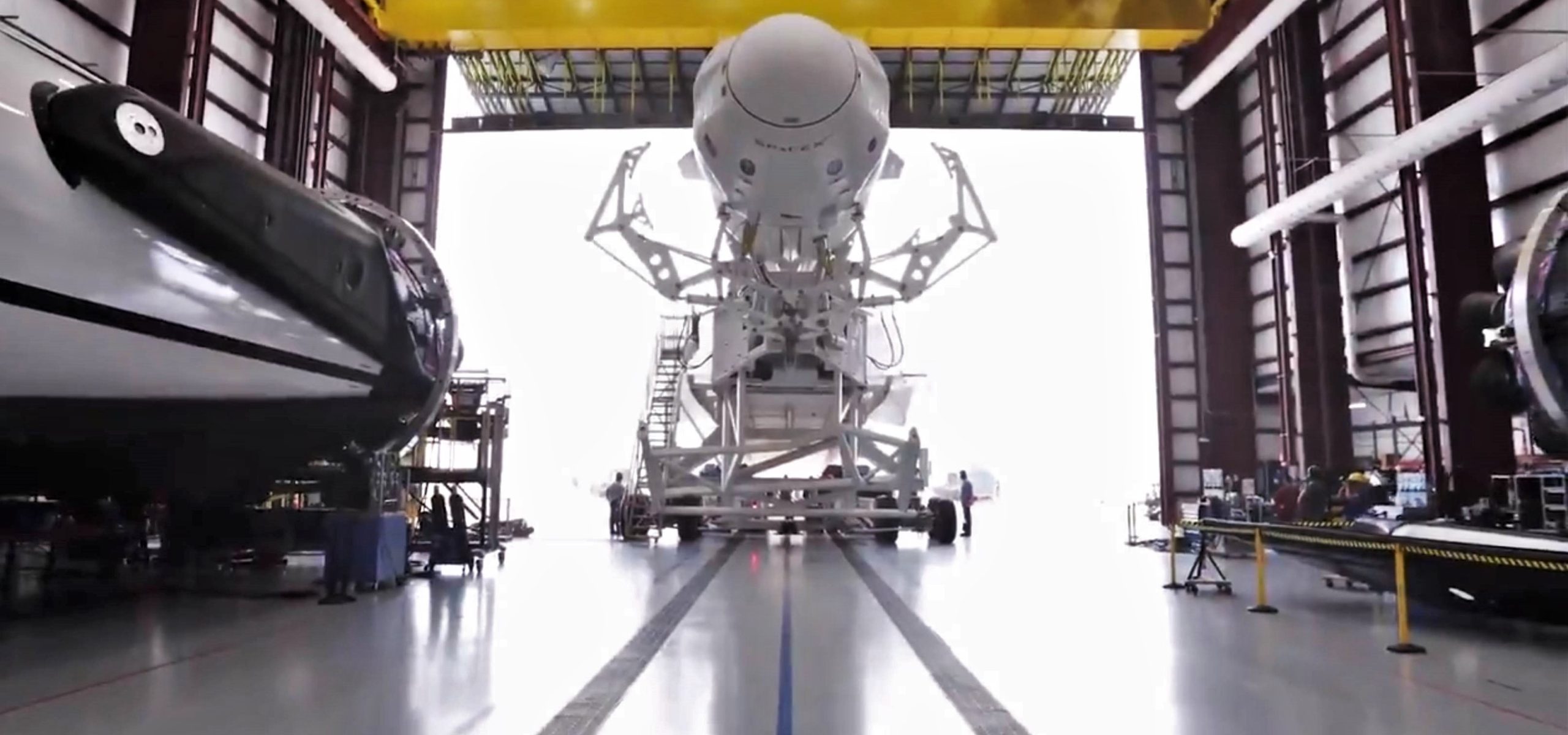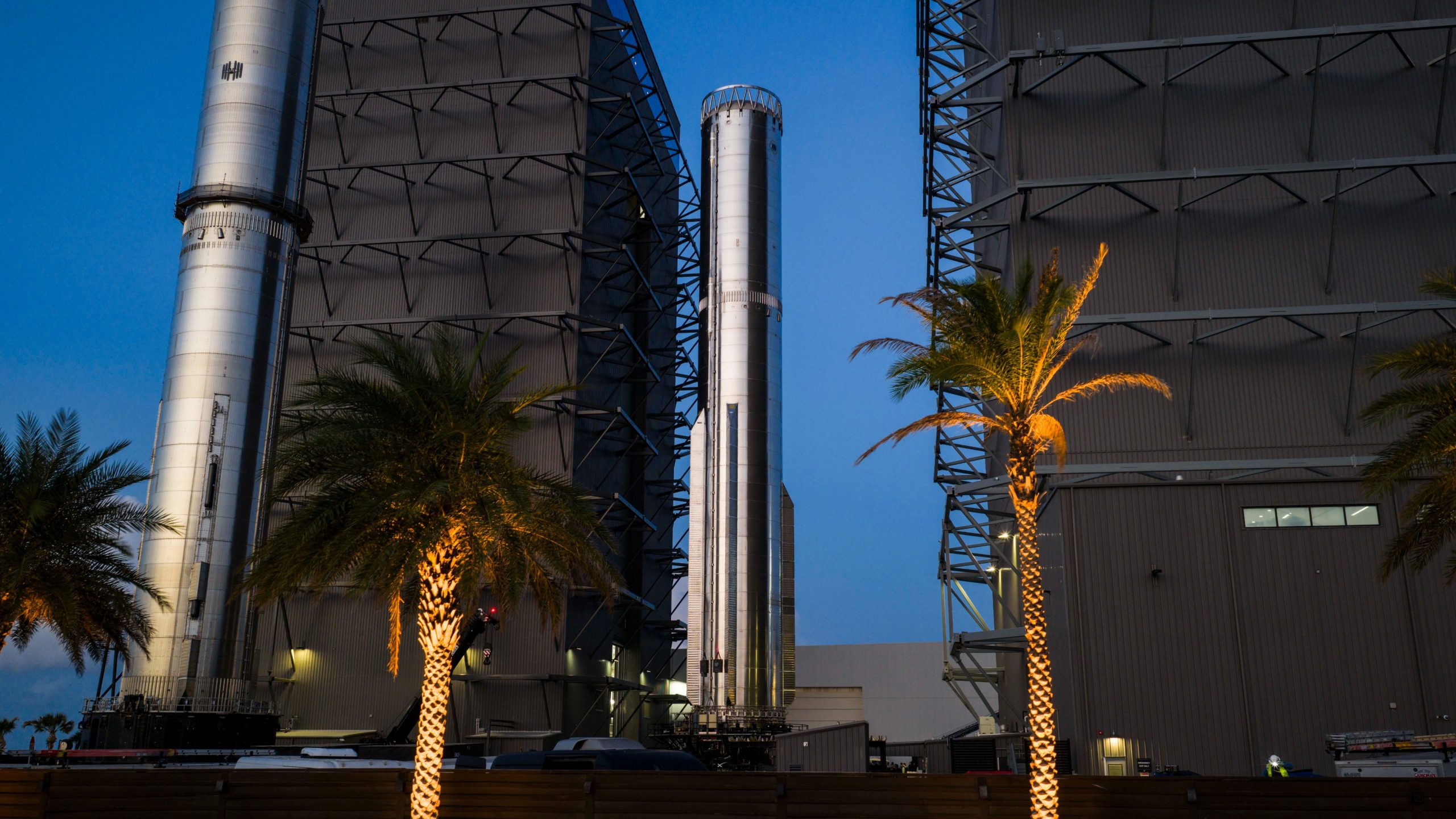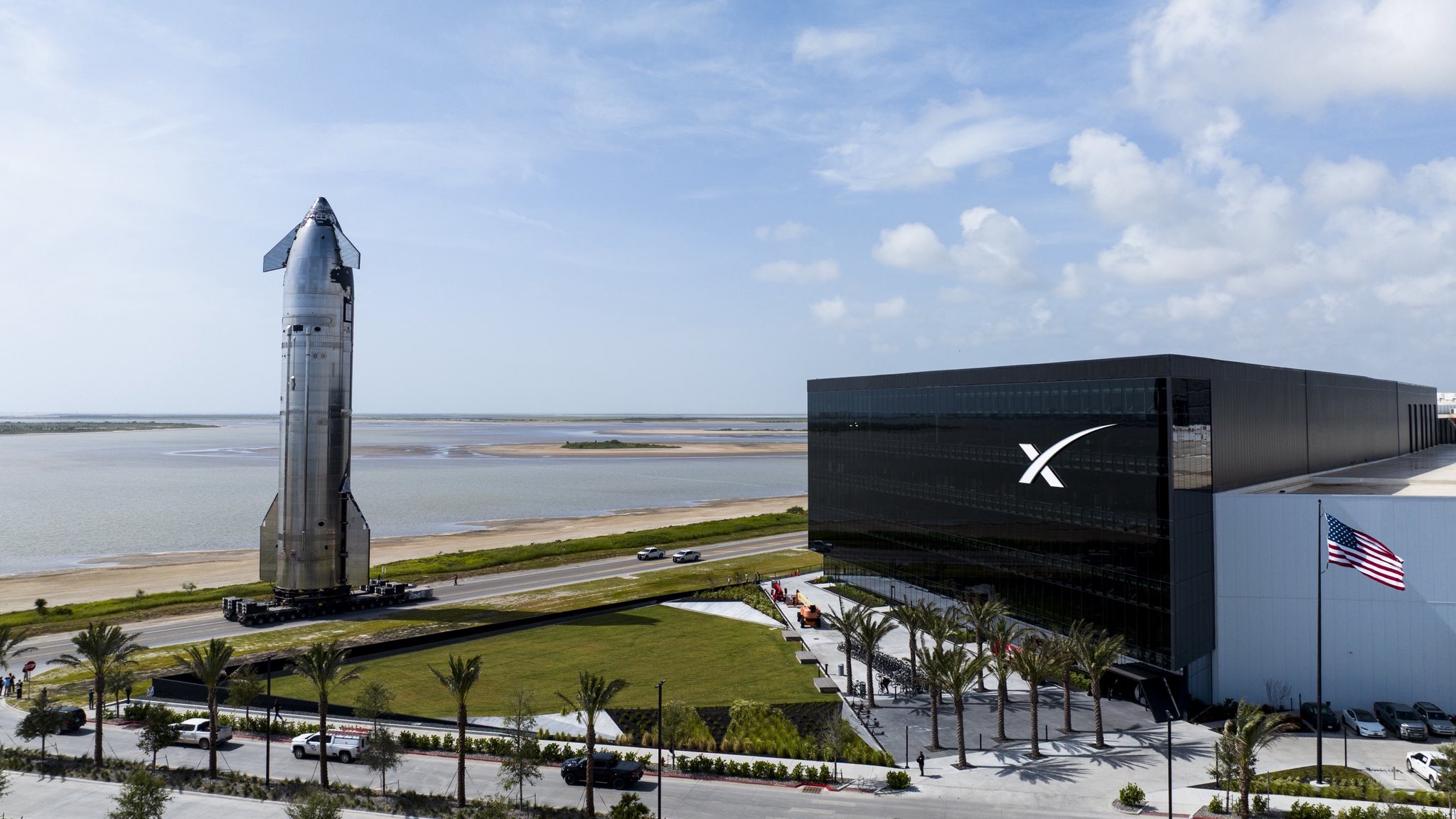

SpaceX
SpaceX hangar packed with Falcon Heavy Block 5 boosters for early April debut
For a company that rarely reveals anything without explicit intent, a February 28th video posted by SpaceX during the lead-up to Crew Dragon’s launch debut featured a surprise cameo: two Block 5 side boosters meant to support Falcon Heavy’s commercial debut and second launch ever.
Likely a subtle nod to close observers and fans, the inclusion of Falcon Heavy is a perfect bit of foreshadowing for the next launch set to occur from Pad 39A after Crew Dragon’s flawless orbital debut. As of now, Falcon Heavy Flight 2 is settling in on a potential launch as early as the first week of April, although delays during the rocket’s critical preflight processing and static fire test are about as likely as they were during the vehicle’s inaugural mission. If the rocket’s first launch and booster recoveries are fully successful, both side boosters (and perhaps the center core) could fly for a second time as few as two months later in June 2019.
A number of photos taken by Instagram users visiting Kennedy Space Center appear to indicate that SpaceX has more or less completed the reconfiguration of Pad 39A’s transporter/erector (T/E), modifying the base with additional hold-down clamps to account for three Falcon boosters instead of the usual one. Ten days after the successful launch of Falcon 9 B1051 in support of Crew Dragon’s first mission to orbit, it’s likely that additional work remains to ensure that 39A is fully refurbished and reconfigured for Falcon Heavy.
For the heavy-lift rocket’s commercial debut and second flight ever, SpaceX is likely to be exceptionally cautious and methodical in their preflight preparations. This is especially necessary due to the fact that Falcon Heavy Flight 2 differs dramatically from Falcon Heavy’s demo configuration, degrading the applicability of some aspects of the data gathered during the rocket’s largely successful test flight.
Most notably, all three first stage boosters will be Block 5 variants on their first flights, whereas Flight 1’s first stage featured two flight-proven Block 2 boosters (B1023 and B1025) and one new Block 3 booster (B1033). Additionally, the center core – B1033 – was lost during a landing anomaly that prevented the booster from reigniting its engine for a landing burn, cutting off another valuable source of data that would have served to better inform engineers on the performance of Falcon Heavy’s complex and previously unproven mechanical stage separation mechanisms.

Falcon 9 Block 5 is a fairly radical departure from the Block 2 and 3 variants SpaceX based Falcon Heavy’s initial design on. It’s possible that the rocket’s engineers were able to at least set up that design and manufacturing work on a safe path to forward compatibility, but it’s equally possible that so much work was focused on simply getting the vehicle past its launch debut that compatibility with Falcon 9 Block 4 and 5 was pushed well into the periphery. Considering the fact that it has now been more than a year since Falcon Heavy’s February 6th, 2018 debut, the latter eventuality offers a much better fit. Nevertheless, with a solid 13-14 additional months of redesign and testing complete, it seems that SpaceX is keen to get its super heavy-lift launch vehicle back on the horse, so to speak.
The specific changes made in Falcon 9 Block 4 is unclear aside from a general improvement in Merlin 1D and MVac performance, as well as significant upgrades to Falcon 9’s upper stage, likely focused on US military and NASA requirements for long-coast capabilities on unique mission profiles. Most significantly, Falcon 9 Block 5 transitioned the SpaceX rocket to a radically different primary thrust structure (also known as the octaweb), replacing welded assemblies with bolted assemblies wherever possible. This simultaneously allows for easier repairs and modifications, improves ease of manufacture, and increases the structure’s overall strength, a critical benefit for Falcon Heavy’s heavily-stressed center core. Meanwhile, Falcon 9 Block 5 moved from Full Thrust’s (Block 3/4) maximum 6800 kN (1,530,000 lbf) of thrust to more than 7600 kN (1,710,000 lbf), an increase of roughly 12%. Combined with Block 5’s focus on extreme reusability, SpaceX engineers and technicians likely had to do a huge amount of work to leap from Falcon Heavy Flight 1 to Flight 2.

Aside from the presence of both Falcon Heavy side boosters, both of which were spotted arriving in Florida by local observers, the first Block 5 Falcon Heavy center core also very likely arrived within the last few months, followed rapidly by can be assumed to be the mission’s fairing and Falcon upper stage. Falcon Heavy’s commercial debut will see the rocket attempt to place communications satellite Arabsat 6A – weighing around 6000 kg (13,200 lb) – into a high-energy geostationary orbit, either direct-to-GEO or a transfer (GTO) variety.
If all goes according to plan, SpaceX will attempt to turn around Falcon Heavy’s Block 5 side boosters (B1052 and B1053) for Falcon Heavy’s third launch – the USAF’s STP-2 mission – as few as 60-80 days later, June 2019. According to NASASpaceflight, STP-2 will fly with a new center core (presumed to be B1057) instead of reusing Arabsat 6A’s well-cooked B1055 booster.
Check out Teslarati’s Marketplace! We offer Tesla accessories, including for the Tesla Cybertruck and Tesla Model 3.

Elon Musk
SpaceX issues statement on Starship V3 Booster 18 anomaly
The incident unfolded during gas-system pressure testing at the company’s Massey facility in Starbase, Texas.

SpaceX has issued an initial statement about Starship Booster 18’s anomaly early Friday. The incident unfolded during gas-system pressure testing at the company’s Massey facility in Starbase, Texas.
SpaceX’s initial comment
As per SpaceX in a post on its official account on social media platform X, Booster 18 was undergoing gas system pressure tests when the anomaly happened. Despite the nature of the incident, the company emphasized that no propellant was loaded, no engines were installed, and personnel were kept at a safe distance from the booster, resulting in zero injuries.
“Booster 18 suffered an anomaly during gas system pressure testing that we were conducting in advance of structural proof testing. No propellant was on the vehicle, and engines were not yet installed. The teams need time to investigate before we are confident of the cause. No one was injured as we maintain a safe distance for personnel during this type of testing. The site remains clear and we are working plans to safely reenter the site,” SpaceX wrote in its post on X.
Incident and aftermath
Livestream footage from LabPadre showed Booster 18’s lower half crumpling around the liquid oxygen tank area at approximately 4:04 a.m. CT. Subsequent images posted by on-site observers revealed extensive deformation across the booster’s lower structure. Needless to say, spaceflight observers have noted that Booster 18 would likely be a complete loss due to its anomaly.
Booster 18 had rolled out only a day earlier and was one of the first vehicles in the Starship V3 program. The V3 series incorporates structural reinforcements and reliability upgrades intended to prepare Starship for rapid-reuse testing and eventual tower-catch operations. Elon Musk has been optimistic about Starship V3, previously noting on X that the spacecraft might be able to complete initial missions to Mars.
Elon Musk
SpaceX Starship Version 3 booster crumples in early testing
Photos of the incident’s aftermath suggest that Booster 18 will likely be retired.

SpaceX’s new Starship first-stage booster, Booster 18, suffered major damage early Friday during its first round of testing in Starbase, Texas, just one day after rolling out of the factory.
Based on videos of the incident, the lower section of the rocket booster appeared to crumple during a pressurization test. Photos of the incident’s aftermath suggest that Booster 18 will likely be retired.
Booster test failure
SpaceX began structural and propellant-system verification tests on Booster 18 Thursday night at the Massey’s Test Site, only a few miles from Starbase’s production facilities, as noted in an Ars Technica report. At 4:04 a.m. CT on Friday, a livestream from LabPadre Space captured the booster’s lower half experiencing a sudden destructive event around its liquid oxygen tank section. Post-incident images, shared on X by @StarshipGazer, showed notable deformation in the booster’s lower structure.
Neither SpaceX nor Elon Musk had commented as of Friday morning, but the vehicle’s condition suggests it is likely a complete loss. This is quite unfortunate, as Booster 18 is already part of the Starship V3 program, which includes design fixes and upgrades intended to improve reliability. While SpaceX maintains a rather rapid Starship production line in Starbase, Booster 18 was generally expected to validate the improvements implemented in the V3 program.
Tight deadlines
SpaceX needs Starship boosters and upper stages to begin demonstrating rapid reuse, tower catches, and early operational Starlink missions over the next two years. More critically, NASA’s Artemis program depends on an on-orbit refueling test in the second half of 2026, a requirement for the vehicle’s expected crewed lunar landing around 2028.
While SpaceX is known for diagnosing failures quickly and returning to testing at unmatched speed, losing the newest-generation booster at the very start of its campaign highlights the immense challenge involved in scaling Starship into a reliable, high-cadence launch system. SpaceX, however, is known for getting things done quickly, so it would not be a surprise if the company manages to figure out what happened to Booster 18 in the near future.
Elon Musk
SpaceX’s next project will produce Starships at a level that sounds impossible
1,000 rockets per year is an insane number, especially considering Starship’s sheer size.

Elon Musk has revealed bold plans for SpaceX’s newest Starbase facility in Texas, predicting it will become a birthplace for “so many spaceships.” The upcoming “Gigabay,” a massive $250 million production hub in Starbase, Texas, is designed to manufacture up to 1,000 Starship rockets per year.
That’s an insane number of rockets for a single facility, especially considering Starship’s sheer size.
One of the world’s largest industrial structures
SpaceX’s Gigabay is expected to stand roughly 380 feet tall and enclose 46.5 million cubic feet of interior space, making it one of the largest industrial structures to date. The facility will feature 24 dedicated work cells for assembling and refurbishing Starship and Super Heavy vehicles, complete with heavy-duty cranes capable of lifting up to 400 U.S. tons, as noted in a Times of India report.
Construction crews have already placed four tower cranes on-site, with completion targeted for December 2026. Once operational, the Gigabay is expected to boost SpaceX’s launch cadence dramatically, as it would be able to build up to 1,000 reusable Starships per year, as noted in a report from the Dallas Express. Musk stated that the Gigabay will be “one of the biggest structures in the world” and hinted that it represents a major leap in Starbase’s evolution from test site to full-scale production hub.
A key step toward Mars and beyond
Starship is SpaceX’s heavy-lift rocket system, and it remains a key part of Elon Musk’s vision of a multiplanetary future. The vehicle can carry 100–150 tonnes to low Earth orbit and up to 250 tonnes in expendable mode. With several successful flights to date, including a perfect 11th test flight, the Starship program continues to refine its reusable launch system ahead of crewed lunar missions under NASA’s Artemis initiative.
Starship is unlike any other spacecraft that has been produced in the past. As per Elon Musk, Starship is a “planet-colonizer” class rocket, as the magnitude of such a task “makes other space transport task trivial.” Considering Starship’s capabilities, it could indeed become the spacecraft that makes a Moon or Mars base feasible.








